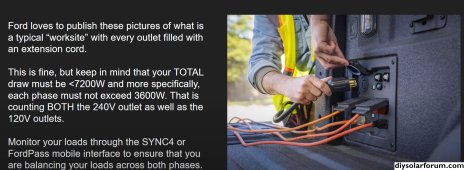Checkthisout
Solar Wizard
- Joined
- Nov 14, 2021
- Messages
- 4,819
I think this is the big hang up in this thread. There is a misconception about what is and isn't grounded if the green wire is not connected on one end. The answer is everything is still grounded. The truck is grounded by the N-G bond at the inverter. The house is grounded by the main bonding jumper in the panel. The cord is still grounded because the green wire is connected on one end or the other, just not both.
I can't imagine the neutral and ground which are bonded in the inverter, are also bonded to the chassis.
The lightning then also has a charging port. Are those a 2 or 3 wire conductor and is that ground even connected to the chassis?
There is a lot going on there. You have 240v incoming going to a charger, a voltage reducer for chassis voltage and then you have battery voltage and then an inverter for 120 volts.
Going to guess Primary battery Negative, Chassis Voltage Negative, Incoming power cord ground and output inverter ground neutral aren't all bonded and connected to the chassis.
So no, with the egc disconnected and some failure mode, you wouldn't get shocked if you touched the truck.



